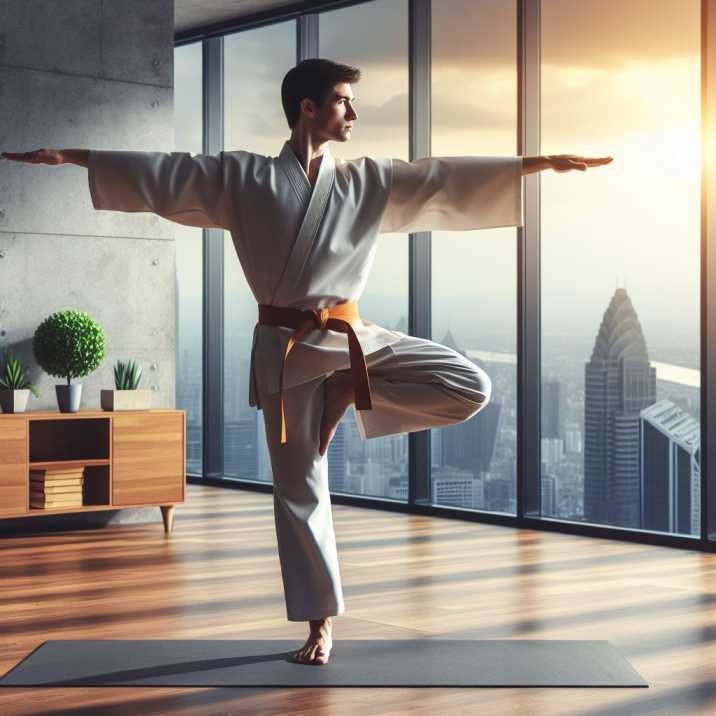Introduction
Table of Contents
Balancing Exercises for Improving Martial Arts Weapon Skills
In the realm of martial arts, wielding weapons is an intricate dance of skill, precision, and agility. Whether it’s the swift strike of a sword or the graceful twirl of a staff, mastering martial arts weapons requires more than just physical strength – it demands balance. In this comprehensive guide, we delve into the world of Balancing Exercises for Improving Martial Arts Weapon Skills.

Why Balancing Exercises Matter in Martial Arts Weaponry
To truly excel in wielding balancing exercises for improving martial arts weapon skills, one must understand the crucial role balance plays in achieving mastery. Balancing exercises not only strengthen your core but also improve proprioception – your body’s awareness of its position in space. This heightened sense of balance translates directly into more fluid and controlled movements when handling weapons.
The Science Behind Balancing Exercises
Understanding the science behind balancing exercises can provide valuable insights into their effectiveness. By challenging your body’s stability, these exercises activate deep core muscles, improve joint stability, and enhance neuromuscular coordination. Incorporating elements of balance training into your martial arts practice can lead to substantial improvements in weapon handling skills.
Types of Balancing Exercises for Improving Martial Arts Weapon Skills
Static Balancing Exercises:
These exercises involve holding a stationary position to challenge your balance. Examples include the tree pose and single-leg stance, which strengthen your lower body and improve stability.
Dynamic Balancing Exercises:
Dynamic exercises, such as lunges and squats on an unstable surface, add an element of movement to balance training. These exercises mimic the unpredictable nature of combat situations, enhancing your ability to maintain balance while in motion.
Proprioceptive Training:
Proprioception-focused exercises, like balancing on a wobble board or stability ball, fine-tune your body’s awareness and control. These drills are particularly beneficial for martial artists seeking to improve their weapon handling precision.
Tips for Incorporating Balancing Exercises into Your Training Routine
Start Slowly and Progress Gradually:
Begin with basic balancing exercises and gradually increase the difficulty as your stability improves.
Focus on Form:
Pay close attention to your form during balancing exercises to ensure proper alignment and maximize effectiveness.
Include Variation:
Incorporate a variety of balancing exercises into your routine to target different muscle groups and keep your training engaging.
Combine with Martial Arts Techniques:
Integrate balancing exercises with specific martial arts weapon techniques to simulate real-world scenarios and enhance skill transfer.
Benefits of Balancing Exercises for Improving Martial Arts Weapon Skills
Improved Stability and Control:
Enhance your ability to maintain stability and control while wielding martial arts weapons, leading to more precise and effective movements.
Injury Prevention:
Strengthening core muscles and improving joint stability through balancing exercises can help reduce the risk of injuries during weapon practice.
Enhanced Performance:
By fine-tuning your balance and proprioception, you’ll experience a noticeable improvement in overall martial arts weapon performance.
Mind-Body Connection:
Balancing exercises cultivate a deeper connection between your mind and body, essential for mastering intricate weapon techniques with ease.
Challenges and Common Mistakes in Balancing Exercises
Overlooking Core Stability:
Neglecting to focus on core stability can hinder your progress in balancing exercises and limit their effectiveness.
Skipping Progression Steps:
Attempting advanced balancing exercises before mastering the basics can lead to frustration and potential injury.
Lack of Consistency:
Inconsistent practice of balancing exercises can impede progress and diminish their impact on martial arts weapon skills improvement.
Ignoring Feedback:
Pay attention to feedback from your body during balancing exercises and adjust accordingly to avoid overexertion or injury.
Incorporating Balancing Exercises into Martial Arts Weapon Training
To fully harness the benefits of balancing exercises, integrate them seamlessly into your martial arts weapon training regimen. Start each session with a brief warm-up focused on balance and stability, then incorporate specific balancing drills into your weapon practice routine. By consistently incorporating balancing exercises into your training, you’ll steadily enhance your martial arts weapon skills and elevate your overall performance.

Conclusion
Balancing exercises are a cornerstone of effective martial arts weapon training, offering a multitude of benefits for practitioners of all levels. By incorporating targeted balancing drills into your routine and paying attention to proper form and progression, you can significantly enhance your stability, control, and overall proficiency in wiezlding martial arts weapons. Embrace the journey of mastering balance, and watch as your martial arts weapon skills reach new heights.
Frequently Asked Questions (FAQs)
- How often should I incorporate balancing exercises into my martial arts weapon training routine?
- It’s recommended to incorporate balancing exercises into your training routine at least 2-3 times per week. Consistency is key to seeing improvements in stability and weapon skills.
- Can beginners with limited balance capabilities benefit from these exercises?
- Absolutely! Balancing exercises can be adapted to suit individuals of all skill levels. Beginners should start with simpler exercises and gradually progress as their balance improves.
- Are there specific balancing exercises that are more beneficial for certain martial arts weapon styles?
- While the fundamentals of balance training apply universally, certain exercises may be more relevant to specific martial arts weapon styles. For example, practitioners of staff-based martial arts may focus more on exercises that enhance upper body stability and coordination.
- Can balancing exercises help with other aspects of martial arts training besides weapon skills?
- Yes, balancing exercises offer a wide range of benefits beyond just improving weapon skills. They can enhance overall agility, core strength, and stability, which are essential for various martial arts techniques and combat scenarios.
- Is it necessary to use specialized equipment for balancing exercises, or can they be performed at home without any props?
- While certain equipment like stability balls or wobble boards can add variety to your balancing exercises, many effective drills can be performed using only your body weight and a stable surface. Simple exercises like single-leg stands or heel-to-toe walks require minimal equipment and can be done anywhere.


